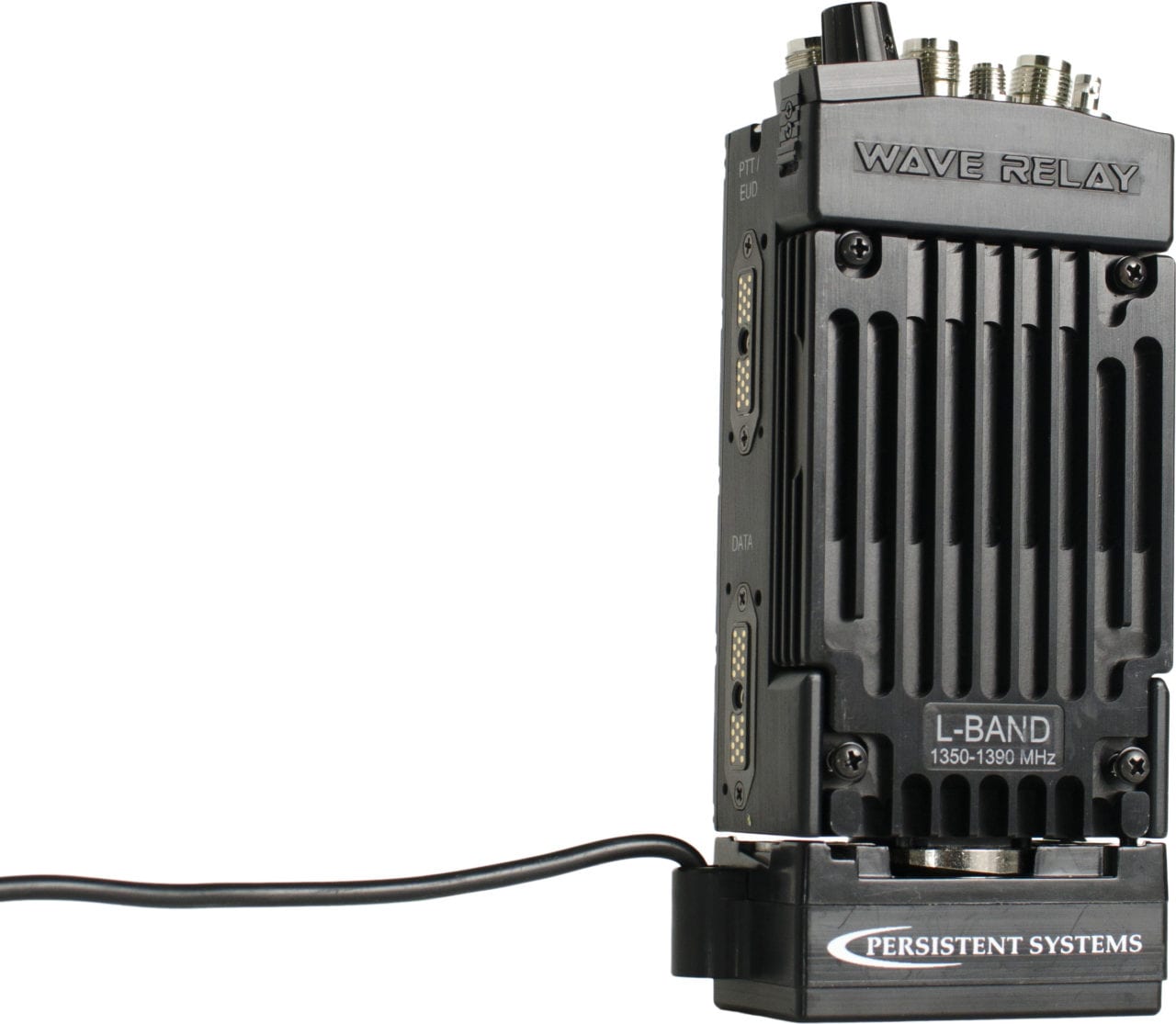
Persistent’s MPU5 handheld radio, here with an additional battery eliminator replacing its battery. (Persistent Systems)
PAE ISR has selected Persistent Systems’ MPU5 Wave Relay mobile ad-hoc radio for use on its Resolute Eagle UAS.
The selling point, according to PAE Chief Technology Officer Jake Jacobs, was the MPU5’s switch-out versatility. The Resolute Eagle is a reconfigurable drone that can operate in both fixed-wing and vertical-takeoff-and-landing (VTOL) modes to meet different missions, so the MPU5’s ability to be set for L, S, or C band connectivity through a quick field-swap makes it a good fit.
“If [a customer] wants something in-theater on C band and that’s busy, we can recover, switch to L or S and takeoff and do the mission,” Jacobs said. “The redundancy of that radio is the main reason why we selected it.”
The MPU5 also offers the Resolute Eagle its calling-card wave relay mobile ad-hoc technology, letting the drone act as a node in a meshed network, repeating and extending that network. Jacobs said as more devices being operated by forces are using meshed networks, adding the capability to take part in that is increasingly valuable. While the growth fit into PAE ISR’s planned roadmap, he also said one customer which he wouldn’t name expressly requested the functionality to benefit their extensive use of meshed networking.
PAE ISR’s Resolute Eagle has a 12-18 hour flying time, depending on its configuration, and payload capacity of 75 lbs. and 900 watts — another benefit of Persistent’s 16-ounce radio is that adopting it frees up 8 lbs. and 100 watts for other uses, Jacobs said. The Resolute Eagle also features a fully autonomous autopilot and an acoustic signature of under 50 decibels at mission altitudes.
PAE’s provides support to military and commercial companies with its aircraft. In November, it won a NAVAIR contract for words. As one of the four prime awardees in the $1.73 billion five-year, indefinite-delivery/indefinite-quantity contract, NAVAIR granted the Resolute Eagle Group 3 interim flight clearance, verifying airworthiness in its VTOL configuration. The new radio “will only have a positive impact” on the aircraft’s performance for NAVAIR, according to Jacobs, though it won’t impact the terms.
The capabilities of the MPU5 were integral to the pitch that PAE ISR made to NASA ahead of an October announcement that the company’s drone will be used in a 2020 demonstration pursuing unmanned air traffic integration into the national airspace system, according to Jacobs.

PAE ISR’s Resolute Eagle unmanned vehicle. (PAE ISR)
“This radio is a big part of our configuration we proposed to NASA, so we see it fitting not only military but commercial applications as well,” he said.
Jacobs described a “wide swathe” of uses for the Resolute Eagle, including pipeline inspection, humanitarian assistance, domestic and foreign military and use by non-military government agencies.
The Persistent radio that will be used on the PAE drone is the handheld version; There is also an embedded version which is actually lighter, but it sacrifices some capabilities that the handheld version has, according to Persistent VP of Business Development Louis Sutherland.
Notably, the version being used on the Resolute Eagle can be used as a bridge for other radios that are not normally compatible. Those radios can be connected to the MPU5, which will convert analog into digital voice signals and switch voice channels appropriately so those different radios can communicate with each other
“For certain customers, that’s a requirement,” Sutherland said.
The radio is multiple-in, multiple-out with two antennas, which allows it to either double up on range or bandwidth. Persistent has tested performance out to a range of 130 miles with military customers, but at half that range, the double-bandwidth option is available, Sutherland said. The top data speeds are around 100 Mbps, but it is reliably in the 30-70 bps range, he said.
The extra range is getting more important than ever, Sutherland said, especially with the U.S. Army and Marines, who are pushing out to unprecedented engagement ranges and spreading out more than ever.
“Most militaries are limited by artillery ranges, limited to about 26 miles for the U.S., but we’re fast-tracking new rounds that will double that range,” Sutherland said. “A side-effect is, we have a larger area to cover for communications. … As a result, these comms relay packages are going to really start popping up in programs of record.”
Sutherland said the new need for long-range communications will put a premium on UAS that can act as communications relays due to their flexibility and mobility.
“Platforms like the Resolute Eagle that will be able to do high-bandwidth, multi-band potentially … various types of configurations, they can provide a footprint for maneuver units,” Sutherland said. “Effectively, it really becomes like a lower satellite, except you’re not paying for the data rate.”